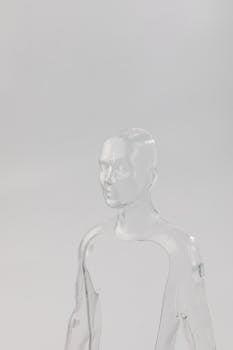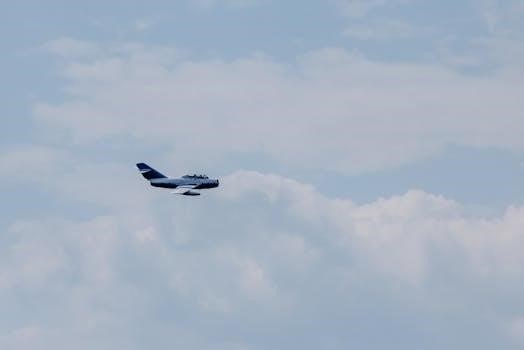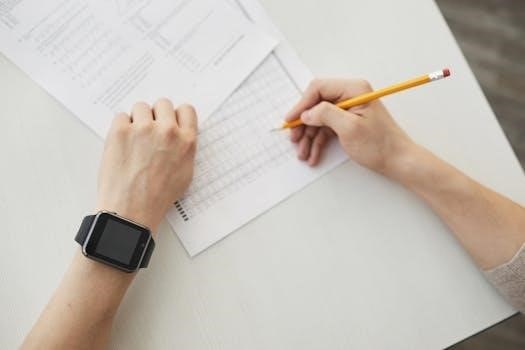cranial nerve tests pdf
Cranial nerve examinations are crucial for assessing neurological function, involving tests for vision, eye movements, and hearing, among others. These exams help identify issues within the 12 cranial nerves, vital for sensory and motor functions.
Purpose of Cranial Nerve Testing
Cranial nerve testing serves a pivotal role in neurological assessments, aiming to pinpoint dysfunctions within the twelve cranial nerves. These nerves are essential for various functions, including vision, eye movements, hearing, facial sensation, and motor control of the tongue. Through specific testing techniques like using a Snellen chart for visual acuity or assessing the pupillary light reflex, clinicians can evaluate the integrity of these neural pathways. The purpose extends to identifying specific cranial nerve deficits, which can indicate underlying pathologies such as tumors, nerve damage, or other neurological conditions. Furthermore, the tests are designed to check both sensory and motor components of each nerve, enabling a comprehensive evaluation. Understanding the purpose allows for targeted treatment and management of neurological disorders. This meticulous approach enables accurate diagnosis, guiding subsequent intervention and enhancing patient outcomes. By evaluating these nerves, medical professionals gain crucial insights into neurological health, ensuring comprehensive patient care.

Cranial Nerve I⁚ Olfactory Nerve
The olfactory nerve, or cranial nerve I, is responsible for the sense of smell. Testing it involves assessing the patient’s ability to detect different odors.
Testing the Sense of Smell
Assessing the olfactory nerve, cranial nerve I, requires careful techniques to evaluate a patient’s sense of smell. The testing procedure typically involves using familiar, non-irritating odors, such as coffee, vanilla, or peppermint. The patient should be instructed to close their eyes and occlude one nostril at a time. A scent is then presented under the open nostril, and the patient is asked to identify it. This process is repeated for the other nostril. It is important to ensure that the patient is not experiencing any nasal congestion or obstruction, as this may affect the results. The ability to identify the odor and whether it is perceived equally in both nostrils are noted during testing. Any asymmetry or inability to detect odors may indicate a problem with the olfactory nerve or the olfactory pathway. Furthermore, the examiner should note if the patient reports any unusual or phantom odors, which may suggest other underlying issues.

Cranial Nerve II⁚ Optic Nerve
The optic nerve, or cranial nerve II, is responsible for vision. Testing involves visual acuity, visual fields, and pupillary responses to light, assessing the nerve’s function.
Visual Acuity Testing with Snellen Chart
The Snellen chart is a fundamental tool for assessing visual acuity, a key component of cranial nerve II examination. This test measures the sharpness of vision, determining the smallest letters a person can read at a specified distance. During the test, a patient stands at a predetermined distance, typically 20 feet, from the chart. Each eye is tested individually, with the other eye covered. The patient reads lines of letters decreasing in size until they can no longer discern them accurately. Results are recorded as a fraction, such as 20/20, which indicates normal vision, or 20/40, which indicates reduced visual acuity. The Snellen chart is critical in identifying visual impairments that may stem from optic nerve dysfunction, helping to pinpoint areas that may require further investigation or treatment. This test is a simple yet effective method for screening visual capabilities. This method is frequently used in routine eye examinations and is essential in neurological assessments.
Pupillary Light Reflex Assessment
The pupillary light reflex assessment is a crucial test evaluating the function of cranial nerves II and III, specifically the optic and oculomotor nerves. This reflex is tested by shining a light into one eye and observing the response of both pupils. Normally, both pupils should constrict simultaneously when light is shone into either eye, a response known as the direct and consensual light reflexes. The direct response refers to the constriction of the pupil in the eye exposed to light, while the consensual response is the constriction of the pupil in the opposite eye. This test helps in determining the integrity of the afferent and efferent pathways involved in the reflex. An abnormal pupillary light reflex can indicate issues with the optic nerve, the oculomotor nerve, or the brainstem. The test is a quick and informative way to identify neurological problems and is an important part of the cranial nerve examination.
Cranial Nerves III, IV, and VI⁚ Oculomotor, Trochlear, and Abducens Nerves
These nerves control eye movement; testing involves observing eye movements as they follow a target in an H-shaped pattern, assessing for any limitations or abnormalities.
Testing Eye Movements with H-Pattern
The H-pattern test is a fundamental method for assessing the function of the oculomotor, trochlear, and abducens nerves, which are responsible for controlling extraocular muscle movement. During this test, the examiner instructs the patient to follow a moving target, such as a finger or pen, as it traces an ‘H’ shape in the air, approximately 30 to 40 centimeters from the patient’s face. This movement allows for the evaluation of smooth pursuit and the range of motion of each eye. The examiner will carefully observe for any limitations in movement, nystagmus or jerky movements, or double vision (diplopia), as these can indicate deficits in one or more of these cranial nerves. The ability of the eyes to move smoothly and in a coordinated manner is essential for proper visual function, and any deviation from the norm can suggest an underlying neurological issue.
Assessment of Visual Reflexes
Visual reflexes, including the pupillary light reflex and accommodation reflexes, are crucial for evaluating the integrity of cranial nerves II and III. The pupillary light reflex assesses both direct and consensual responses by shining a light into one eye and observing the constriction of that pupil (direct) and the other pupil (consensual). This test evaluates the afferent pathway via the optic nerve (CN II) and the efferent pathway via the oculomotor nerve (CN III). Additionally, visual accommodation is examined by observing pupillary constriction as the eyes focus on a near object. A hand placed vertically along the patient’s nose can block light from entering the opposite eye during pupillary light reflex testing, ensuring a reliable assessment of each eye’s direct response. Any abnormalities in these reflexes may suggest underlying neurological issues impacting these cranial nerves and their associated pathways.
Cranial Nerve V⁚ Trigeminal Nerve
The trigeminal nerve, essential for facial sensation and chewing, requires sensory testing with light touch and pinprick assessments to evaluate its functionality and integrity.
Sensory Testing of the Face
Sensory testing of the face, a key component of the trigeminal nerve examination, involves assessing both light touch and pinprick sensations across different facial regions. This evaluation helps determine the integrity of the three branches of the trigeminal nerve, which innervate the ophthalmic, maxillary, and mandibular areas. During the light touch assessment, a soft object, such as a cotton swab, is gently applied to the patient’s face, and they are asked to indicate when they feel the sensation. For the pinprick assessment, a sterile pin or a safety pin with a blunt edge is used to test for sharp and dull sensations; It’s crucial to demonstrate these sensations to the patient beforehand, ensuring they understand what to expect. Furthermore, comparing sensation on both sides of the face is vital for identifying any asymmetry or deficits, possibly indicating a lesion or neuropathy along the nerve pathway. This meticulous approach to testing is essential for accurately identifying trigeminal nerve dysfunction.

Cranial Nerve VIII⁚ Vestibulocochlear Nerve
The vestibulocochlear nerve, crucial for hearing and balance, is assessed through tests like the finger rub test and the Rinne test. These methods help determine its functionality.
Hearing Assessment with Finger Rub Test
The finger rub test serves as a preliminary assessment of hearing acuity, utilizing a simple technique to evaluate the vestibulocochlear nerve’s function. The examiner gently rubs their fingers together near each of the patient’s ears, one at a time, to assess the ability to perceive the sound. The patient is asked to indicate when they can hear the rubbing sound. This method provides a basic indication of hearing, but it does not discern the specific type of hearing loss. If hearing is diminished, further tests like the Weber and Rinne test may be used for a more comprehensive diagnosis. The finger rub test is a quick, easy method for identifying gross hearing deficits, providing an initial evaluation of the patient’s auditory capabilities. It is important to perform this test in a quiet environment to prevent any extraneous noises from interfering with the results. This test helps determine if further auditory evaluation is needed.
Rinne Test for Air and Bone Conduction
The Rinne test is an essential component in evaluating hearing by comparing air and bone conduction. A tuning fork is struck and placed on the mastoid process behind the ear, assessing bone conduction. The patient indicates when the sound is no longer audible. Subsequently, the vibrating tuning fork is held near the ear canal, assessing air conduction. The patient then indicates if they can hear the sound again. Typically, air conduction is perceived longer and louder than bone conduction in normal hearing. If bone conduction is heard longer, it suggests a conductive hearing loss. This test helps differentiate between conductive and sensorineural hearing loss, providing crucial diagnostic information about the vestibulocochlear nerve’s function. The Rinne test is instrumental in determining the nature of hearing impairments, guiding further assessment and management. Accurate execution of this test is vital for obtaining reliable results.

Cranial Nerve XII⁚ Hypoglossal Nerve
The hypoglossal nerve, the twelfth cranial nerve, controls tongue movements. Assessment involves observing tongue deviation and mobility, crucial for speech and swallowing functions, indicating potential nerve damage.
Tongue Movement and Deviation Assessment
Evaluating the hypoglossal nerve’s function involves carefully observing tongue movement and any deviations. The assessment begins with the patient protruding their tongue straight out; any deviation to one side suggests weakness on that side, possibly due to nerve damage or a local tumor affecting the hypoglossal nerve. Specifically, if the tongue deviates to the left, it indicates a problem with the left hypoglossal nerve, and vice-versa. The examiner should also note any fasciculations, which are involuntary muscle twitches, or the bulk of the tongue, which can indicate atrophy. Furthermore, reduced tongue mobility could be evident and this is essential to record during the examination. These findings are critical for diagnosing the underlying cause of any issues with swallowing, speech, or tongue control, and can be indicative of a variety of neurological conditions that require further investigation. The observation is typically done with the patient’s mouth open and the tongue fully extended for a clear view.



































